Development of Open-Assistant Environment for Integrated Operation of 3D Bridge Model and Engineering Document Information
Abstract
:1. Introduction
2. Document Analysis and Translation to Structured Format
2.1. Translation Process from Unstructured Engineering Document to XML Document
2.2. Content Analysis of Engineering Documents
- The string represents a set of characters with a finite sequence; here, , , and is the set of all the characters, including space, in a given document;
- In , the symbol ‘’ implies that A can be expressed as B;
- The symbol ‘|’ represents ‘or’.
2.3. Identification of Bullet-Form Text Strings
2.4. Identification of Hierarchical Structure of Subtitles
2.5. Performance Evaluation of Document Translation Module
3. IFC-Based Bridge Information Modeling with Document Metadata
3.1. IFC Schema for Bridge Model and Document Information
- IFC4.3RC4 is a schema under development that has not yet been officially released. Therefore, current BIM authoring tools, such as Autodesk Revit, cannot handle the information generated by IFC4.3RC4;
- Information on the bridge structure components covered by IFC4.3RC4 is limited; it does not define bridge-specific and bridge-related attributes that should be treated as entity and attribute level.
3.2. Assistant Module for Integrated Management of Bridge Model and Document Information
4. Experimental Verification via Retrieval of Document Fragments Related to the 3D Model Object
4.1. Process of the Experimental Verification for Connected Document Fragments and 3D Model Object
4.2. Connection Review of the Retrieved Document Fragments and the 3D Model Objects
5. Conclusions
- Document content management using the IFC: Although the IFC contains most of the information that needs to be dealt with during the entire lifecycle of a facility, few studies suggest a technical process to control the document fragments. This study explained how IFC manages document fragments with examples;
- Smart infrastructure: The successful adaptation of BIM for buildings promotes the growth of BIM for infrastructure for operating smart infrastructure. Interoperability, as well as data mapping between physical and digital models, are considered to be some of the essential keys of successful BIM for infrastructure [31,32]. The integrated operation process of the BIM authoring tool–IFC–engineering document proposed in this study can be a good reference.
Author Contributions
Funding
Conflicts of Interest
References
- Tatum, C.B. Integration: Emerging management challenge. J. Manag. Eng. 1990, 6, 47–58. [Google Scholar] [CrossRef]
- Park, S.I.; Park, J.; Kim, B.G.; Lee, S.H. Improving applicability for information model of an IFC-based steel bridge in the design phase using functional meanings of bridge components. Appl. Sci. 2018, 8, 2531. [Google Scholar] [CrossRef] [Green Version]
- Preidel, C.; Borrmann, A. BIM-based code compliance checking. In Building Information Modeling—Technology Foundations and Industry Practice; Borrmann, A., König, M., Koch, C., Beetz, J., Eds.; Springer International Publishing AG: Cham, Switzerland, 2018; pp. 367–381. [Google Scholar]
- Lin, J.R.; Hu, Z.Z.; Zhang, J.P.; Yu, F.Q. A Natural-Language-Based Approach to Intelligent Data Retrieval and Representation for Cloud BIM. Comput.-Aided Civ. Infrastruct. Eng. 2016, 31, 18–33. [Google Scholar] [CrossRef]
- ISO 10303-22:1998; Industrial Automation Systems and Integration—Product Data Representation and Exchange—Part 22: Implementation Methods: Standard Data Access Interface. International Organization for Standardization (ISO): Geneva, Switzerland, 1998.
- Hjelseth, E.; Nisbet, N. Capturing normative constraints by use of the semantic mark-up rase methodology. In CIB W78-W102 2011 28th International Conference—Applications of IT in the AEC Industry; Blackwell Publishing Ltd.: Sophia Antipolis, Valbonne, France, 2011; pp. 241–250. [Google Scholar]
- Beach, T.; Rezgui, Y.; Li, H.; Kasim, T. A rule-based semantic approach for automated regulatory compliance in the construction sector. Expert Syst. Appl. 2015, 42, 5219–5231. [Google Scholar] [CrossRef] [Green Version]
- Sydora, C.; Stroulia, E. Rule-based compliance checking and generative design for building interiors using BIM. Autom. Constr. 2020, 120, 103368. [Google Scholar] [CrossRef]
- Zhong, B.T.; Ding, L.Y.; Luo, H.B.; Zhou, Y.; Hu, Y.Z.; Hu, H.M. Ontology-based semantic modeling of regulation constraint for automated construction quality compliance checking. Autom. Constr. 2012, 28, 58–70. [Google Scholar] [CrossRef]
- Zhou, P.; El-Gohary, N.M. Ontology-based automated information extraction from building energy conservation codes. Autom. Constr. 2017, 74, 103–117. [Google Scholar] [CrossRef]
- Liu, K.; El-Gohary, N.M. Ontology-based semi-supervised conditional random fields for automated information extraction from bridge inspection reports. Autom. Constr. 2017, 81, 313–327. [Google Scholar] [CrossRef]
- Al Qady, M.; Kandil, A. Concept relation extraction from construction documents using natural language processing. J. Constr. Eng. Manag. 2010, 136, 294–302. [Google Scholar] [CrossRef]
- Zhang, J.; El-Gohary, N.M. Semantic NLP-based information extraction from construction regulatory documents for automated compliance checking. J. Comput. Civ. Eng. 2016, 30, 04015014. [Google Scholar] [CrossRef] [Green Version]
- Song, J.; Lee, J.K.; Choi, J.; Kim, I. Deep learning-based extraction of predicate-argument structure (PAS) in building design rule sentences. J. Comput. Des. Eng. 2020, 7, 563–576. [Google Scholar] [CrossRef]
- Wang, Z.; Wang, Y.; Gao, K. A new model of document structure analysis. In Lecture Notes in Computer Science—Fuzzy Systems and Knowledge Discovery; Wang, L., Jin, Y., Eds.; Springer: Berlin/Heidelberg, Germany, 2005; pp. 658–666. [Google Scholar]
- Eastman, C.M.; Lee, J.m.; Jeong, Y.S.; Lee, J.K. Automatic rule-based checking of building designs. Autom. Constr. 2009, 18, 1011–1033. [Google Scholar] [CrossRef]
- Jiang, S.; Wang, N.; Wu, J. Combining BIM and Ontology to Facilitate Intelligent Green Building Evaluation. J. Comput. Civ. Eng. 2018, 32, 04018039. [Google Scholar] [CrossRef]
- Zhou, P.; El-Gohary, N.M. Semantic information alignment of BIMs to computer-interpretable regulations using ontologies and deep learning. Adv. Eng. Inform. 2021, 48, 101239. [Google Scholar] [CrossRef]
- Ma, Z.; Li, H.; Shen, Q.P.; Yang, J. Using XML to support information exchange in construction projects. Autom. Constr. 2004, 13, 629–637. [Google Scholar] [CrossRef]
- Kim, B.G.; Park, S.I.; Kim, H.J.; Lee, S.H. Automatic extraction of apparent semantic structure from text contents of a structural calculation document. J. Comput. Civ. Eng. 2010, 24, 313–324. [Google Scholar] [CrossRef]
- Park, S.I.; Lee, S.H. Heuristic solution using decision tree model for enhanced XML schema matching of bridge structural calculation documents. Front. Struct. Civ. Eng. 2021, 14, 1403–1417. [Google Scholar] [CrossRef]
- Choi, J.; Choi, J.; Kim, I. Development of BIM-based evacuation regulation checking system for high-rise and complex buildings. Autom. Constr. 2014, 46, 38–49. [Google Scholar] [CrossRef]
- Opitz, F.; Windisch, R.; Scherer, R.J. Integration of document - and model-based information for project management support. Procedia Eng. 2014, 85, 403–411. [Google Scholar] [CrossRef] [Green Version]
- Park, S.I.; Lee, S.H.; Almasi, A.; Song, J.H. Extended IFC-based strong form meshfree collocation analysis of a bridge structure. Autom. Constr. 2020, 119, 103364. [Google Scholar] [CrossRef]
- buildingSMART International MSG. Industry Foundation Classes Release 4.0.2.1. 2017. Available online: https://standards.buildingsmart.org/IFC/RELEASE/IFC4/ADD2_TC1/HTML/ (accessed on 2 July 2021).
- buildingSMART International MSG. Industry Foundation Classes Release 4.3RC4. 2021. Available online: https://github.com/bSI-InfraRoom/IFC-Documentation/tree/main/4_3_0_0/rc4 (accessed on 3 July 2021).
- Autodesk. Revit—Multidisciplinary BIM Software for Higher-Quality, Coordinated Designs. 2021. Available online: https://www.autodesk.com/products/revit/overview (accessed on 2 July 2021).
- World Wide Web Consortium (W3C). DOM. 2021. Available online: https://dom.spec.whatwg.org/#what (accessed on 18 July 2021).
- Kleene, S.C. Representation of Events in Nerve Nets and Finite Automata. U.S. Air Force. 1951. Available online: https://www.rand.org/content/dam/rand/pubs/research_memoranda/2008/RM704.pdf (accessed on 20 December 2021).
- World Wide Web Consortium (W3C). XML Path Language (XPath) 3.1. 2017. Available online: https://www.w3.org/TR/2017/REC-xpath-31-20170321/ (accessed on 10 July 2021).
- Costin, A.; Adibfar, A.; Hu, H.; Chen, S.S. Building Information Modeling (BIM) for transportation infrastructure—Literature review, applications, challenges, and recommendations. Autom. Constr. 2018, 94, 257–281. [Google Scholar] [CrossRef]
- Merenda, M.; Praticò, F.G.; Fedele, R.; Carotenuto, R.; Corte, F.G.D. A Real-Time Decision Platform for the Management of Structures and Infrastructures. Electronics 2019, 8, 1180. [Google Scholar] [CrossRef] [Green Version]

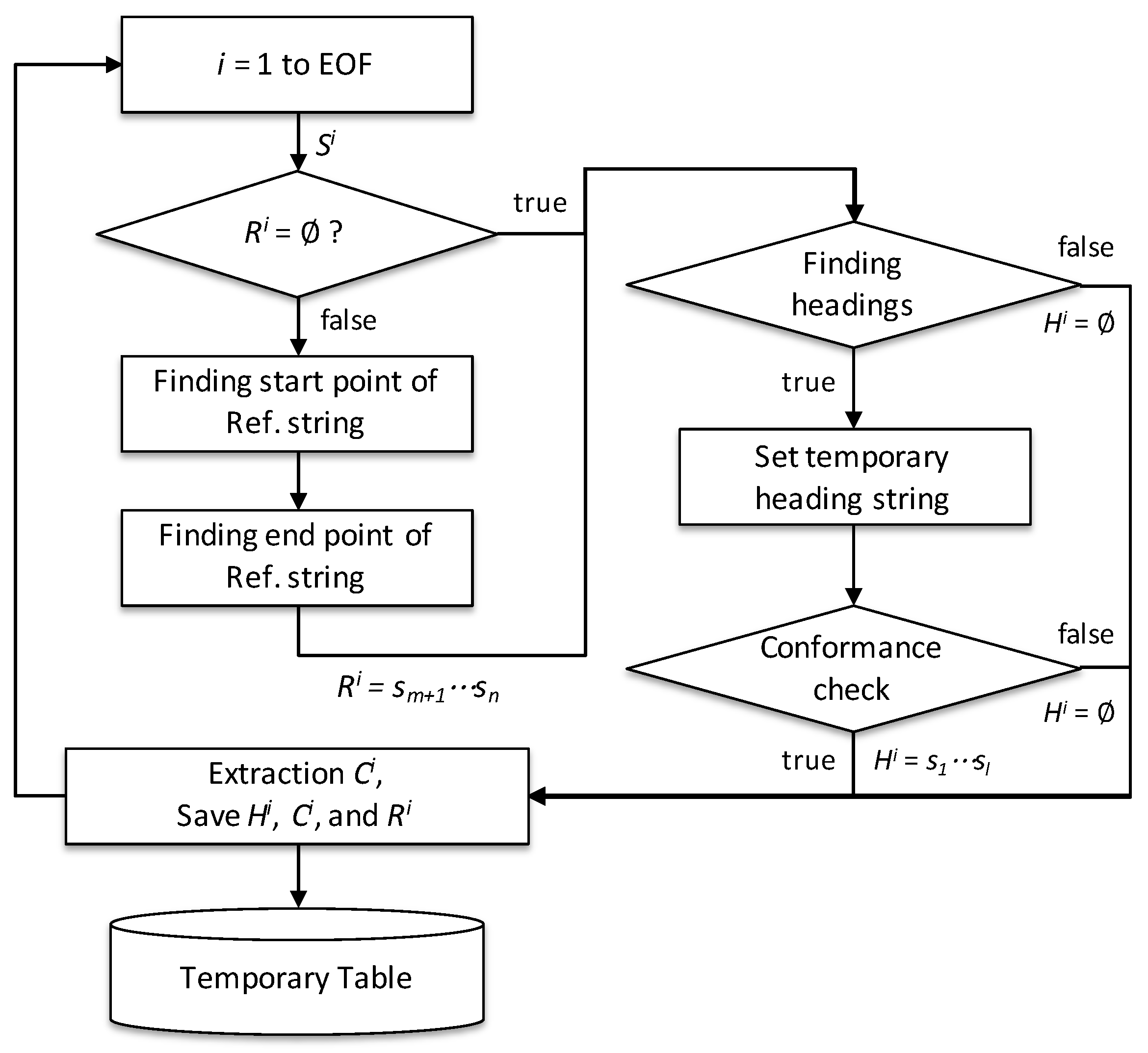
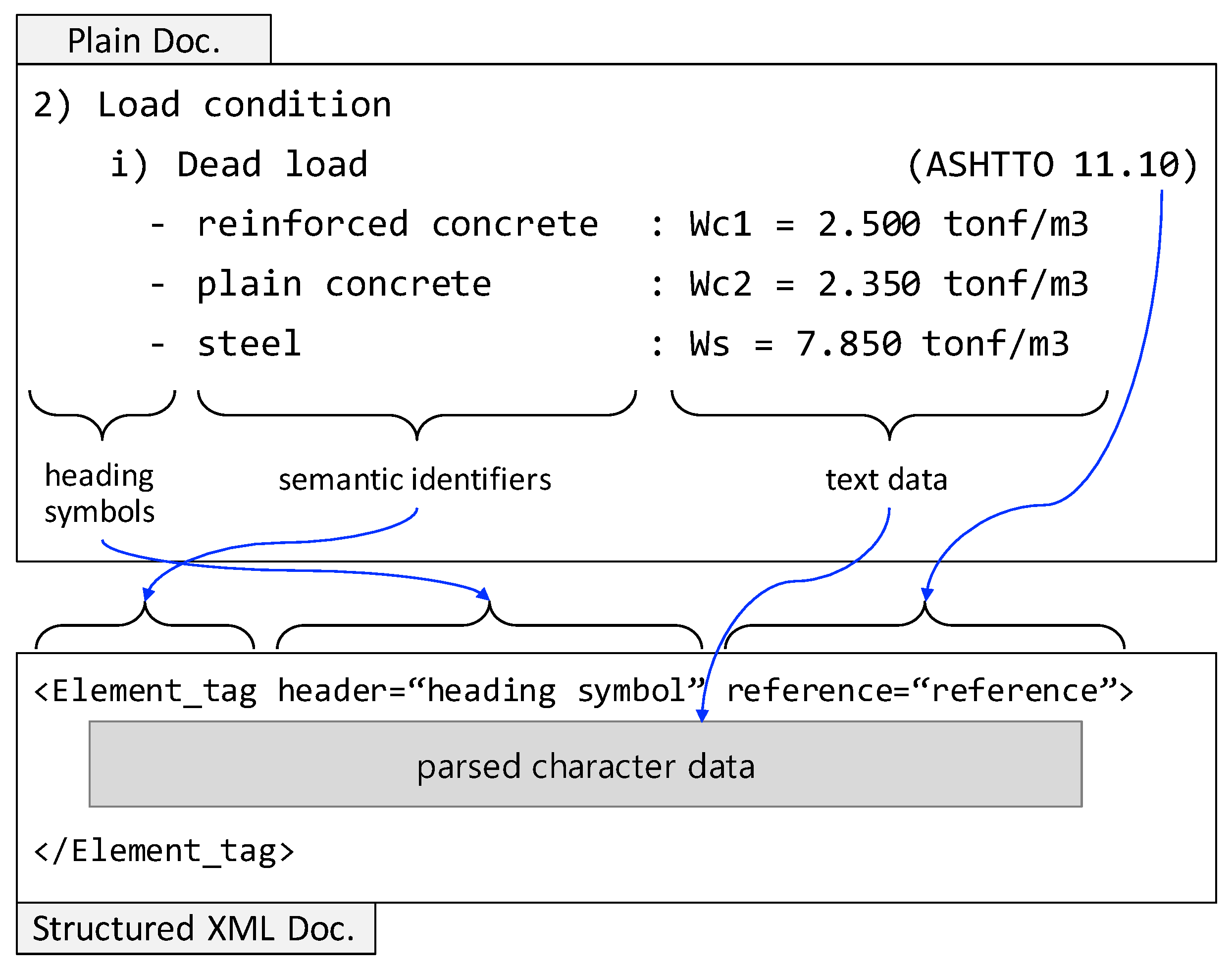

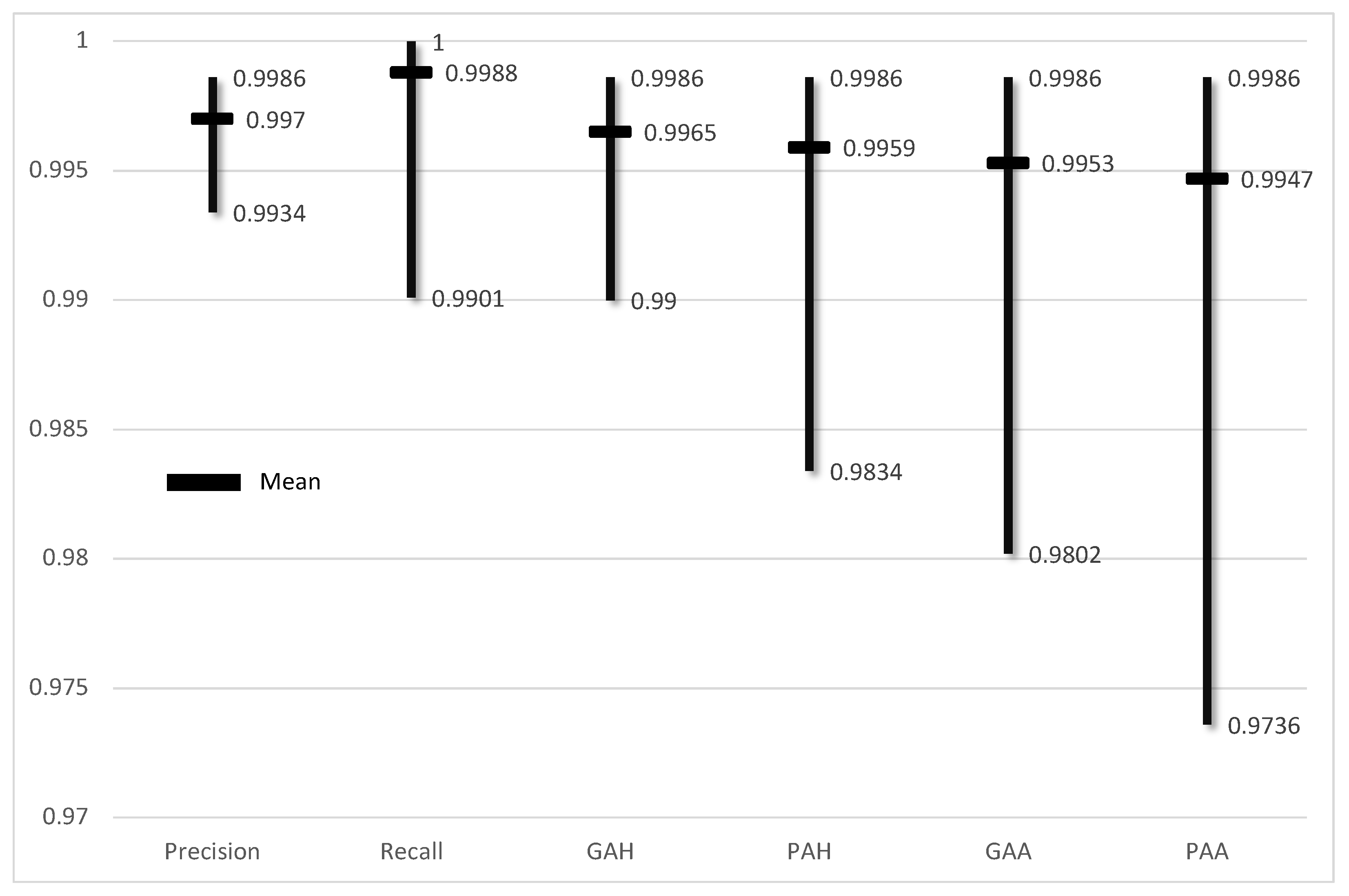
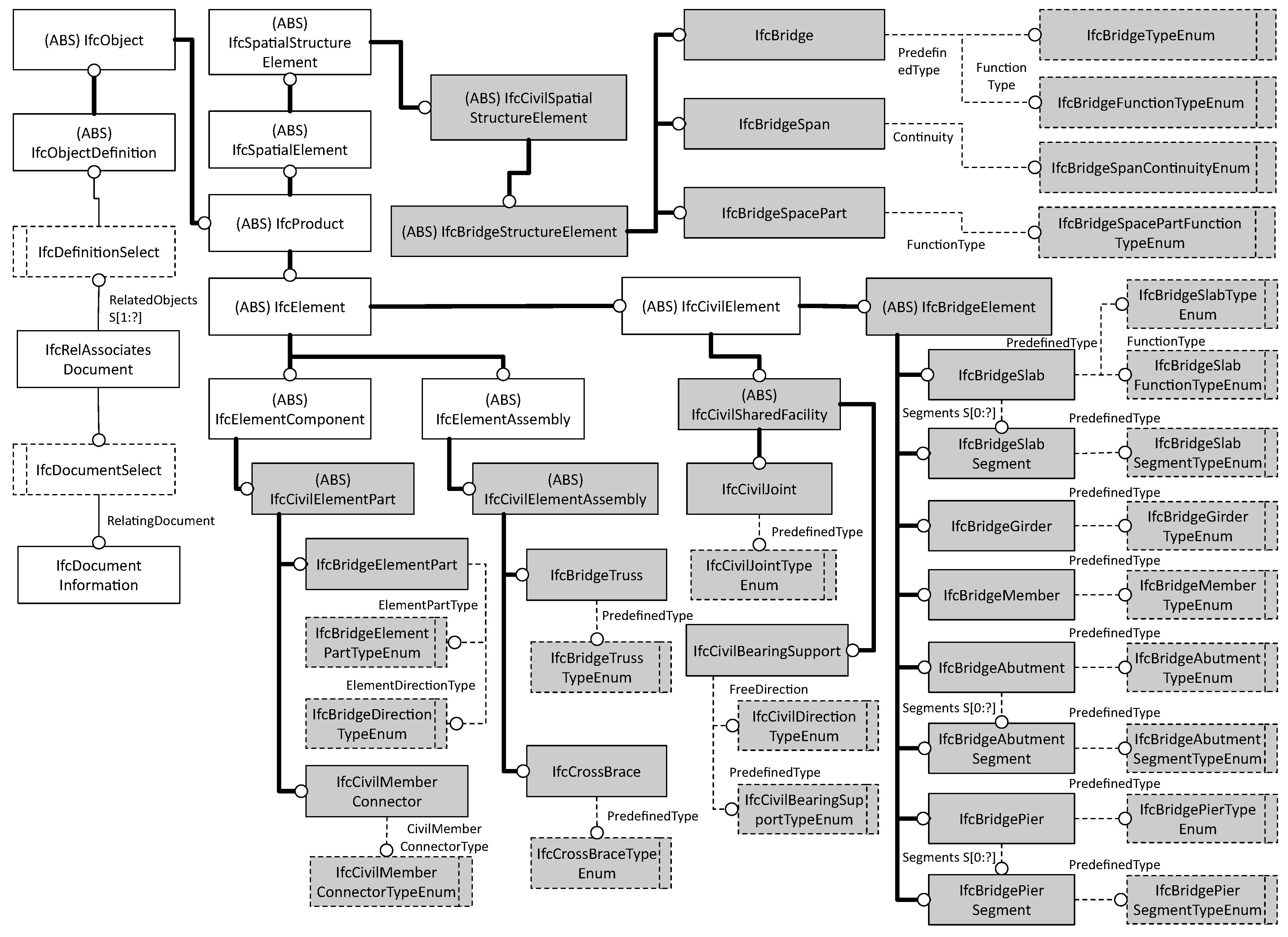
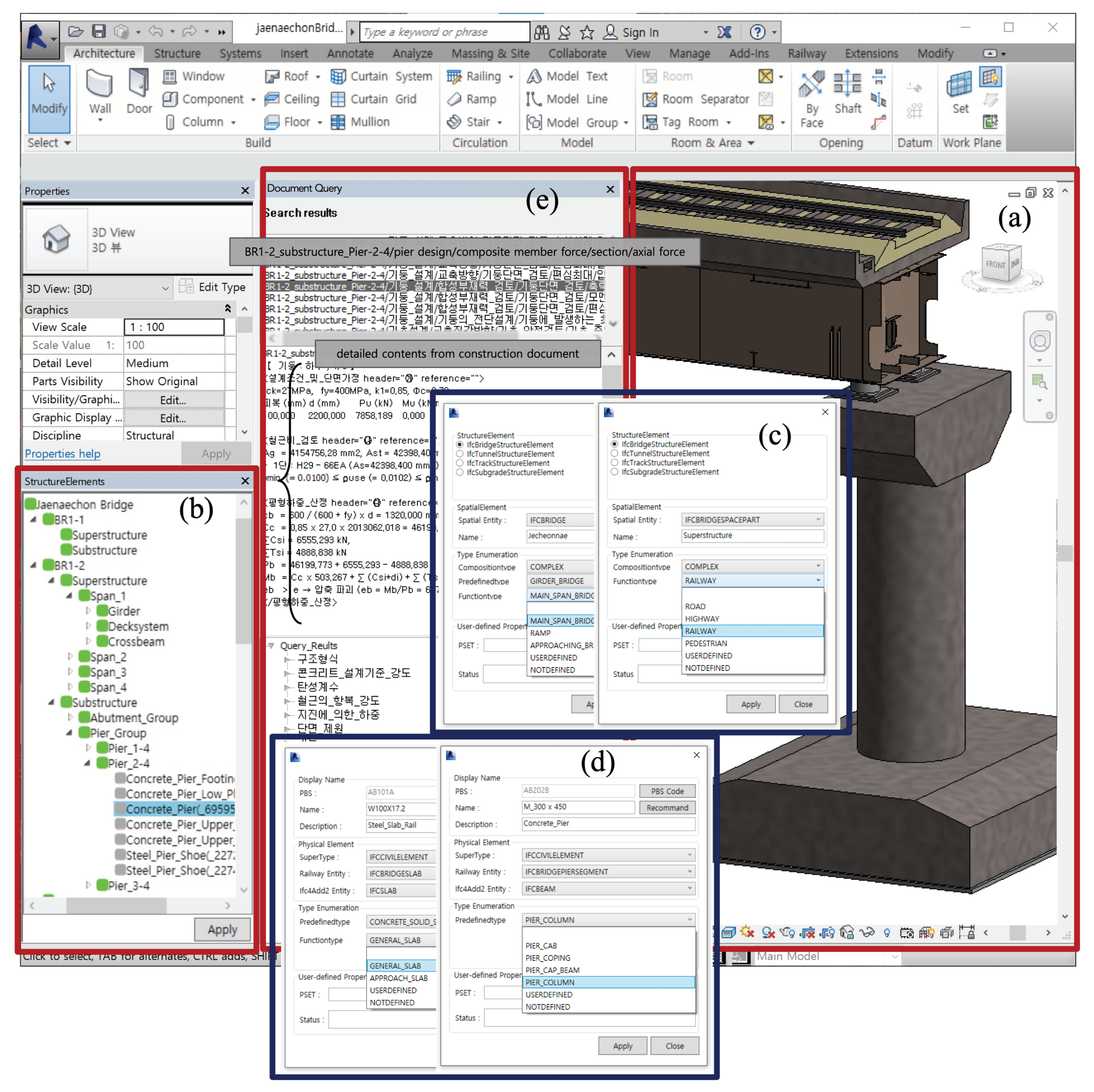

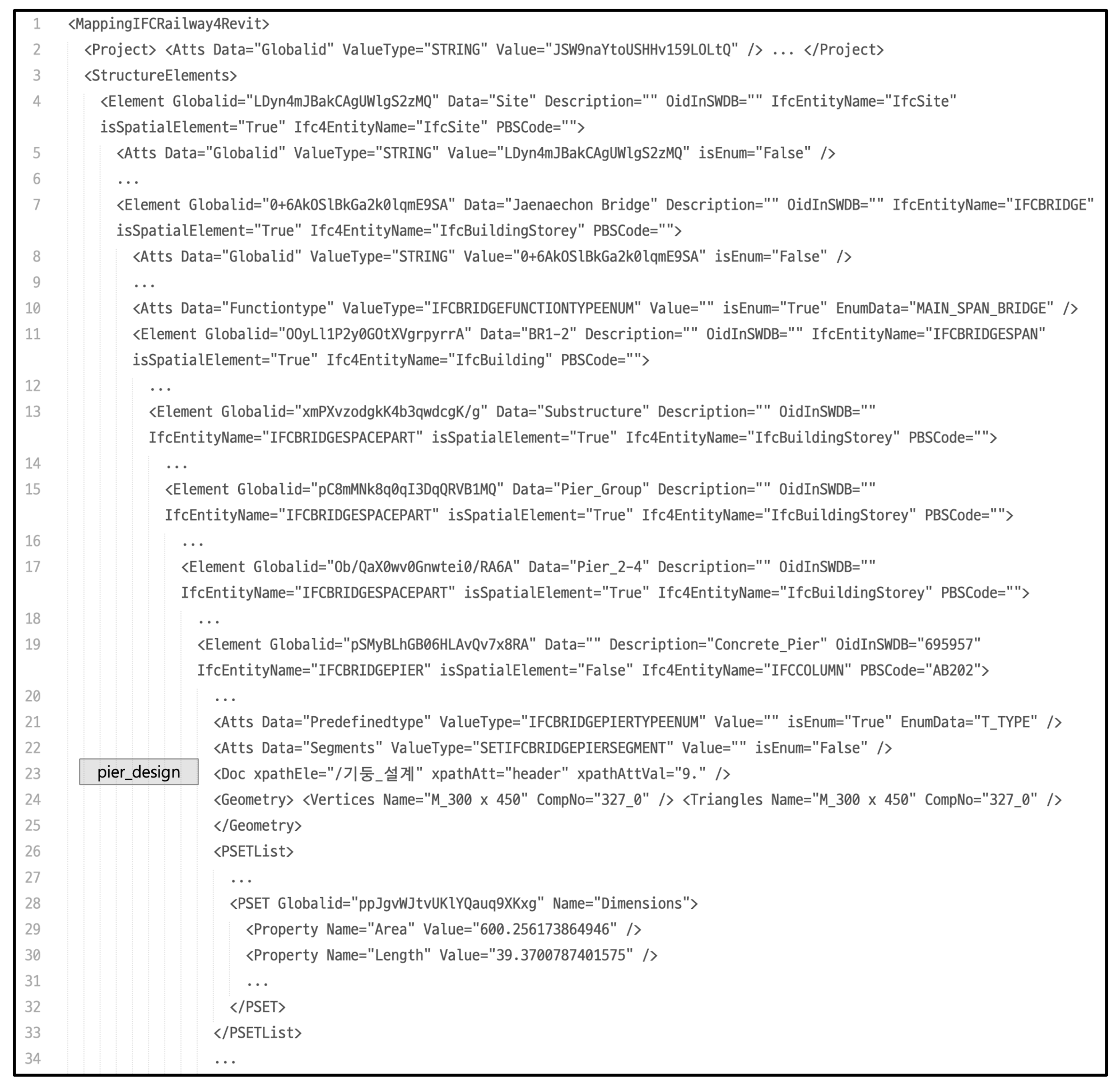
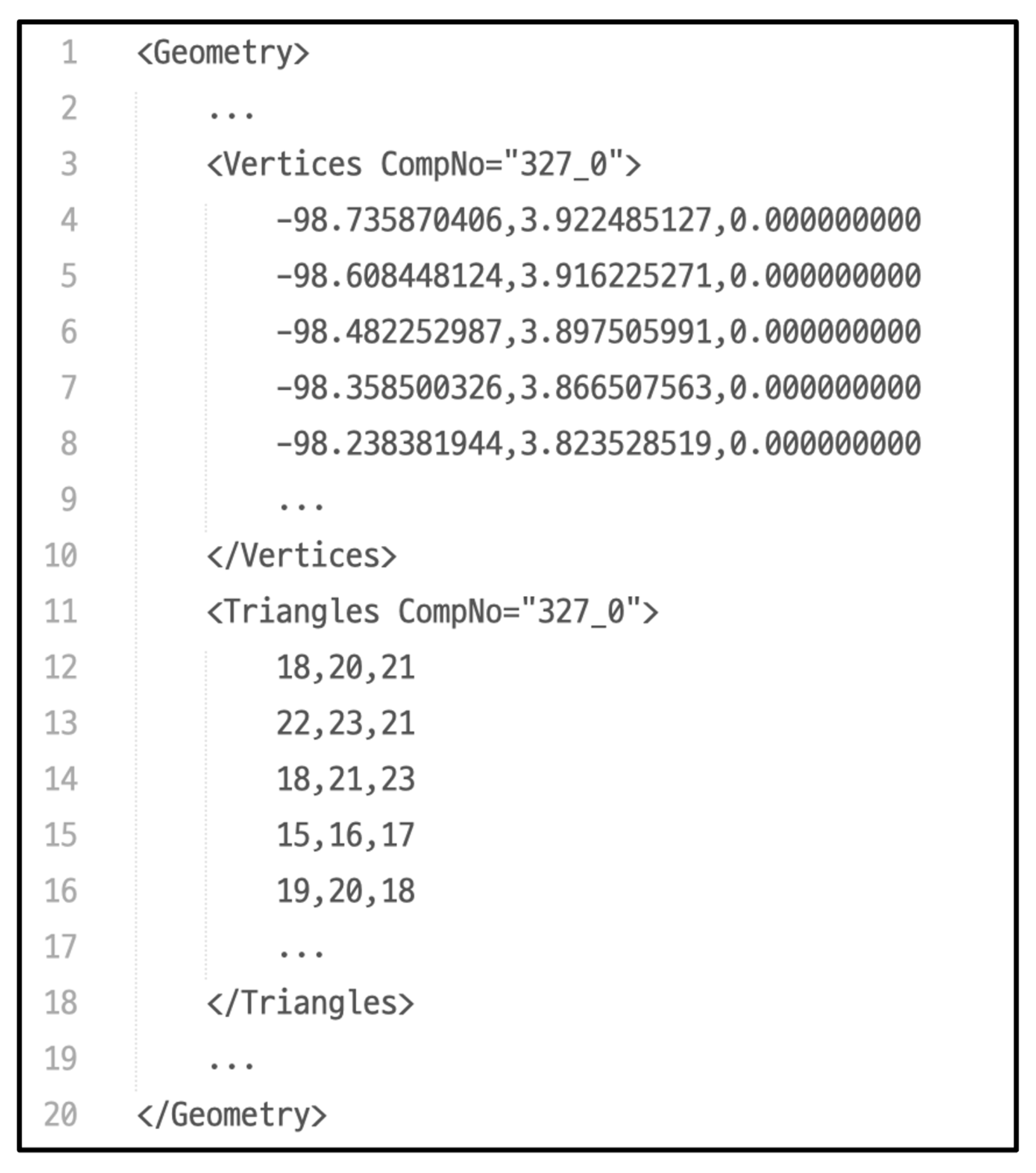
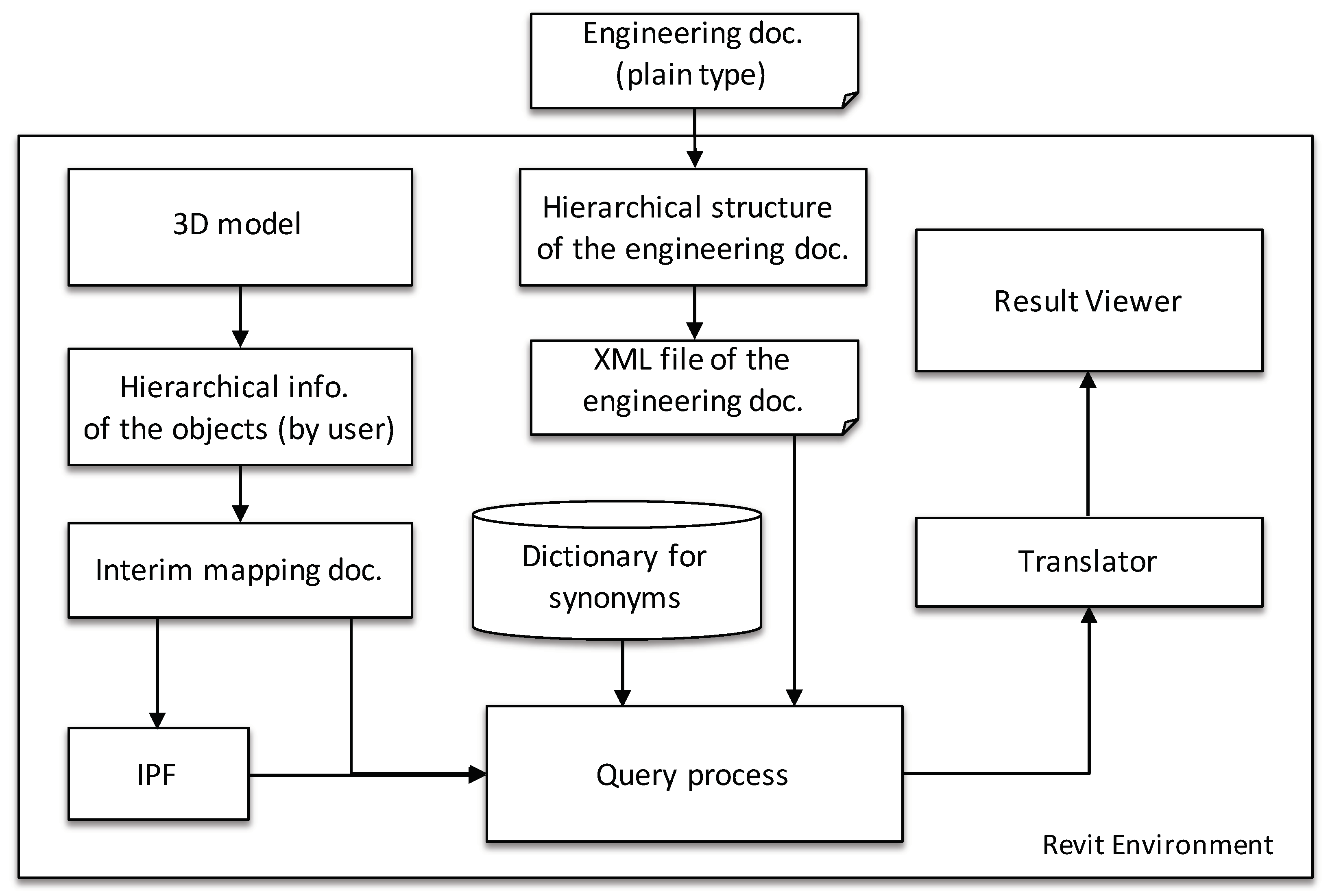


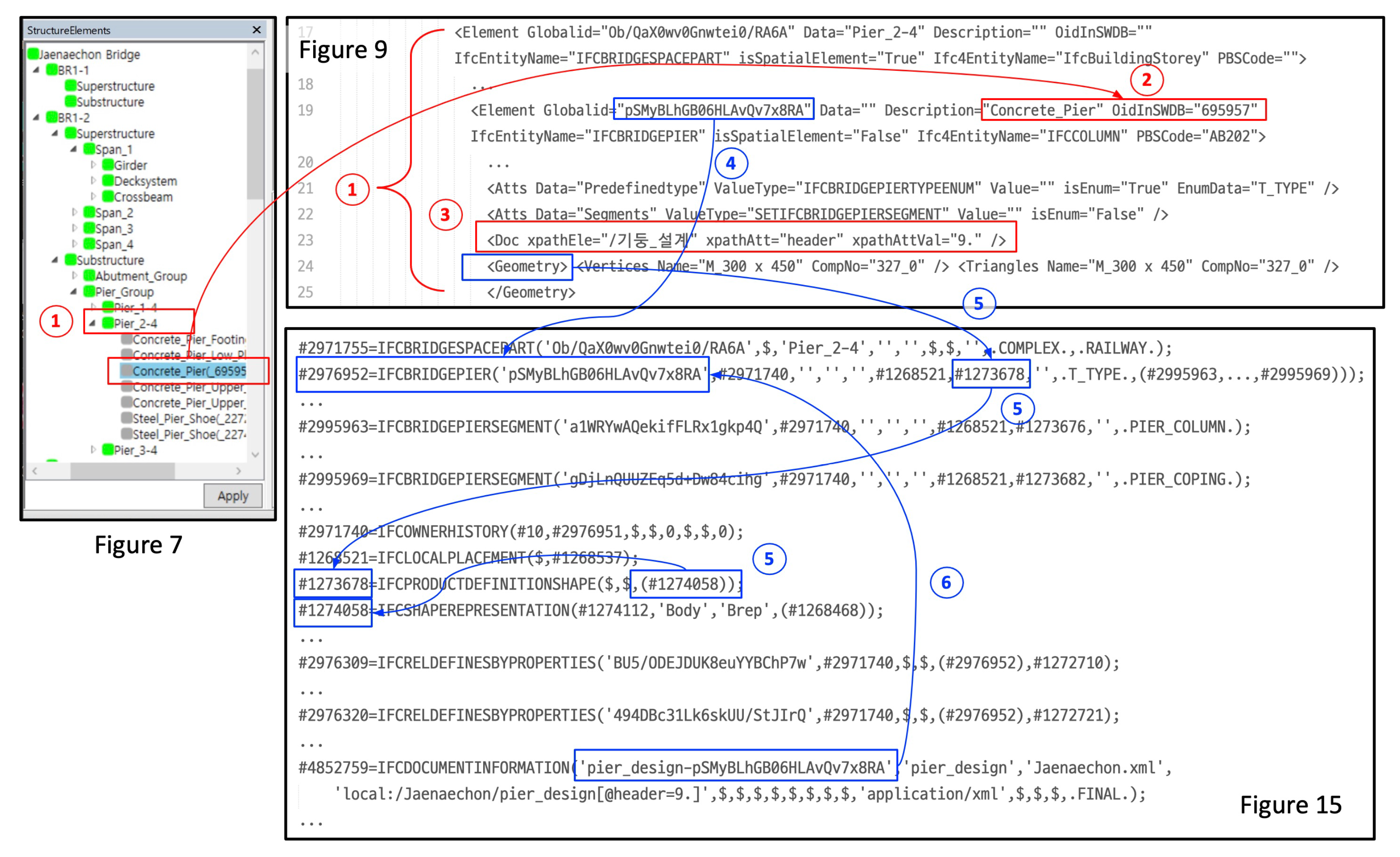

| Previous Study | Extraction of 3D Model Info. | Extraction of Doc. Info. | Integration, Mapping Method | Limitation |
|---|---|---|---|---|
| Hjelseth and Nisbet [6] | X | RASE 1 methodology | Not proposed | Integration method between 3D model and doc. Info. was not proposed. |
| Zhong et al. [9] | X | CQIEOntology 2 (Manual) | Not proposed | Integration method between 3D model and doc. Info. was not proposed. |
| Choi et al. [22] | IFC | X | IFC user-defined property sets (PSETs) | Regulation codes must be mapped into IFC PSETs manually. |
| Opitz et al. [23] | IFC schema | X | SQL and BIMfit Model Query | The document content should already be stored in DB in a fragile state. |
| Beach et al. [7] | IFC | Extended RASE (RASE + XML tag) | Experts performed the mapping between the code fragments and IFC entities. | Mapping was performed manually. |
| Zhou and El-Gohary [10] | IFC | Rule-based OBIE 3 algorithm | IFC–SIE 4–logic facts transformation | OBIE algorithm highly depends on specific knowledge domain (building energy conservation codes). |
| Sydora and Stroulia [8] | IFC | Rule Language (manual) | IFC-based automatic mapping | The information should be organized to interpret into rule language manually. |
Publisher’s Note: MDPI stays neutral with regard to jurisdictional claims in published maps and institutional affiliations. |
© 2022 by the authors. Licensee MDPI, Basel, Switzerland. This article is an open access article distributed under the terms and conditions of the Creative Commons Attribution (CC BY) license (https://creativecommons.org/licenses/by/4.0/).
Share and Cite
Park, S.I.; Kim, B.-G.; Goh, W.; Zi, G. Development of Open-Assistant Environment for Integrated Operation of 3D Bridge Model and Engineering Document Information. Appl. Sci. 2022, 12, 2510. https://doi.org/10.3390/app12052510
Park SI, Kim B-G, Goh W, Zi G. Development of Open-Assistant Environment for Integrated Operation of 3D Bridge Model and Engineering Document Information. Applied Sciences. 2022; 12(5):2510. https://doi.org/10.3390/app12052510
Chicago/Turabian StylePark, Sang I., Bong-Geun Kim, Wonhui Goh, and Goangseup Zi. 2022. "Development of Open-Assistant Environment for Integrated Operation of 3D Bridge Model and Engineering Document Information" Applied Sciences 12, no. 5: 2510. https://doi.org/10.3390/app12052510
APA StylePark, S. I., Kim, B.-G., Goh, W., & Zi, G. (2022). Development of Open-Assistant Environment for Integrated Operation of 3D Bridge Model and Engineering Document Information. Applied Sciences, 12(5), 2510. https://doi.org/10.3390/app12052510







